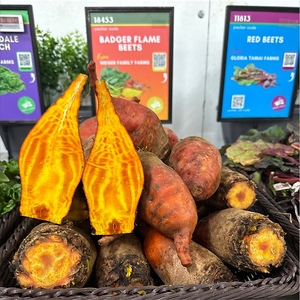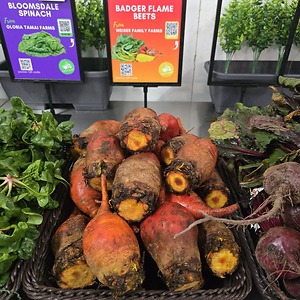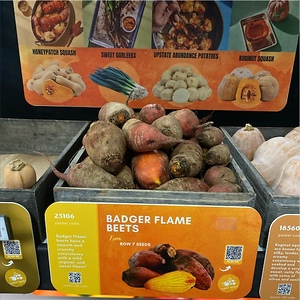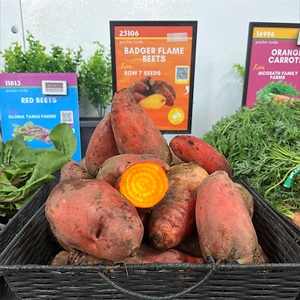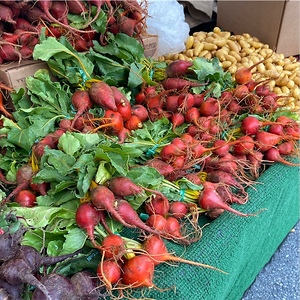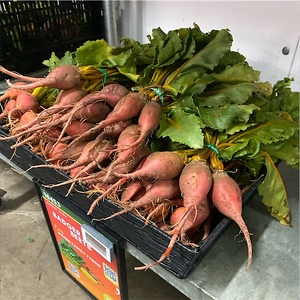


Badger Flame Beets
Estimated Inventory, bunch : 0
Description/Taste
Badger Flame beets are cylindrical roots, averaging 15 to 17 centimeters in length, and have an elongated shape that tapers to a pointed tip on the non-stem end. The skin is semi-smooth, firm, and dark red-orange, sometimes covered in small hairs, and the roots are connected to long, leafy green tops. Underneath the skin, the flesh is dense, crisp, aqueous, and bright gold to orange, with pale yellow to white, concentric rings and irregular designs scattered across the surface. It is important to note that the color of the root will intensify and deepen over time, giving the root a changing appearance. Badger Flame beets have a smooth and crunchy consistency with a mild, vegetal, and sweet flavor.
Seasons/Availability
Badger Flame beets are available year-round.
Current Facts
Badger Flame beets, botanically classified as Beta vulgaris, are a modern, specialty variety that belongs to the Amaranthaceae family. The elongated roots were named after their vibrant, golden flesh, flame-like shape, and the descriptor badger was selected in honor of the University of Wisconsin’s mascot. Badger Flame beets were the product of many years of selective trials and crossings at the University of Wisconsin, and the variety was created from a new method of breeding, focusing on chef-approved flavor with unique aesthetic qualities. When Badger Flame beets were released to the market in 2018, they were highly praised for their unusual shape, vibrant coloring, sweet flavor, and versatile nature. The most notable characteristic of the variety is its lack of geosmin, which is an organic compound found within beet flesh that gives the root it’s earthy, dirt-like flavor. Badger Flame beets represent a new, contemporary cultivar that is changing the perception of what beets should taste like in consumer markets with their sweet, non-earthy taste. The roots are also edible when raw and are utilized in a wide variety of culinary applications.
Nutritional Value
Badger Flame beets are a good source of vitamins A and C, which are antioxidants that can help boost the immune system, increase collagen production, and improve vision. The beets also contain beta-carotene, potassium, and fiber, which can stimulate the digestive system.
Applications
Badger Flame beets are best suited for both raw and cooked applications such as roasting and steaming. The entire plant is edible, including the greens, and Badger Flame beets have a sweet flavor without the earthiness commonly associated with beets. The roots can be peeled into thin ribbons and tossed into salads, mixed with light dressings as a side dish, or used as a pasta substitute with other spiralized vegetables. They can also be steamed for a tender texture, thinly sliced and roasted into wedges and chips, smoked for a deeper flavor, or pickled for extended use. In addition to the roots, the leaves can be lightly stir-fried or sautéed, steeped into a tea, or minced and mixed with cheeses as a ravioli filling. Badger Flame beets pair well with nuts such as hazelnuts, walnuts, and pecans, herbs such as parsley, dill, basil, and thyme, cheeses such as ricotta, goat, and feta, citrus, fennel, and microgreens. The roots will keep up to six months when stored whole and unwashed with the leaves removed in the crisper drawer of the refrigerator.
Ethnic/Cultural Info
In Austin, Texas, February of 2020 has been declared the month of the “Badger Flame Beet Invasion.” This marketing campaign was created by Urban American Farmer and is a part of a “seed to pop-up” event series to promote unusual produce throughout the city. Urban American Farmer first pitched this idea with the intent to give back to the local community and promote innovation in the food sector, eventually receiving a five-thousand-dollar grant from the Austin Food & Wine Alliance Culinary Program to implement the campaign. The campaign began in October of 2019 when Badger Flame beets were planted at Urban Roots Farm with the help of local kids from the Austin community to create a large enough supply of roots for the event. During the month of February, the mature roots are harvested fresh and are used by chefs across Austin in main dishes, desserts, appetizers, and beverages. This campaign seeks to promote creativity among local chefs, educate Austin citizens of the diverse variety of produce available, and encourage partnership between the community, farms, and chefs.
Geography/History
Badger Flame beets were initially created by breeder Irwin Goldman and Nick Breitbach at the University of Wisconsin in the United States. It took over fifteen years for the variety to be created through natural crossings and selective breeding, and throughout its research phase, the earthy compound geosmin was eliminated from the root’s genes. The variety was also improved through field trials at the Stone Barns Center for Food and Agriculture with the help of Jack Algiere and Matthew Goldfarb in New York. Badger Flame beets were released to the market in 2018 through Row 7 Seeds, a New York-based seed company that creates innovative, environmentally friendly, and quality flavored produce. Today Badger Flame beets can be found through select licensed growers at farmer’s markets and specialty grocers in the United States, Canada, and Mexico. The variety is also available through online seed catalogs for home garden use.
Recipe Ideas
Recipes that include Badger Flame Beets. One
| Meatless Makeovers |
|
Badger Flame Beet Carpaccio |
| Stone Barns Center |
|
Beet Salsa |



